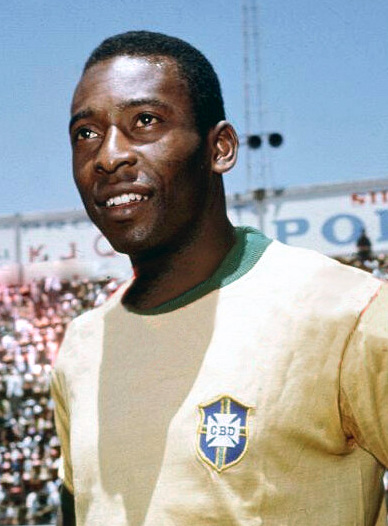By Raj
The story of a small-town boy name Edson Arantes do Nascimento, lovingly called “Pele” by the world. This boy didn’t just play football; he learned to live his dreams with every kick. His journey is a tale that touches all our hearts.

Introduction: A Name That Is Immortal
Whenever football is mentioned, one name always comes to mind—Pele. A name that is not just a player but an example, a dream that began in the soil of a small town and shone brightly in stadiums worldwide. Pele’s journey teaches us that dreams do come true if you have the courage to live them.
Early Life: Small Beginnings, Big Dreams
Pele was born on October 23, 1940, in the small town of Três Corações, Brazil. His childhood was spent under the shadow of poverty, but his passion was greater than his dreams.
He started playing football by making one with a sock stuffed with cloth. His father, who was a football player himself, ignited that spark within him. And from there, Pele’s journey began.
At the age of 15, he started playing for Santos FC. Even then, the world began to realize that this boy was different. The time had come for a star to be born.
Career Highlights: When the World Saluted Pele
Pele’s name spread across the globe when he showcased his talent during the 1958 FIFA World Cup. A boy of only 17 years, but his goals held the power to win a world. In the final, he scored two goals, leading Brazil to victory and engraving his name in history.
The 1970 World Cup was a masterpiece. Under Pele’s leadership, Brazil won a World Cup that people still call “The Greatest Team Ever.” In every match, his skill, passion, and magic left everyone awestruck.
He didn’t just win World Cups; he won hearts. From New York to Nigeria, people took his name as if he was a dream come true.
Playing Style and Strengths: The Magic of an Artist
Pele’s game wasn’t just about power; it had elegance, poetry in motion. When he touched the ball, it felt as if a melody was created.
- Master of Dribbling: Defenders were always left chasing him.
- Versatile: Right foot, left foot, headers—he was a champion at everything.
- Game Reading: He was always one step ahead, as if he had a map of the future in his mind.
- Physical Strength: Despite his modest height, his jumping and power were unmatched.
Every match was a stage for him, and his game was a performance.
Challenges and Comebacks: Pele’s Fighting Spirit
When injuries plagued him during the 1966 World Cup, the world questioned, “Can Pele come back?” But Pele answered with his glorious performance in the 1970 World Cup, reaching the peak of his game.
He turned every challenge into a new beginning. When life tested him, he proved his critics wrong every single time. His fighting spirit teaches us that defeat is just a pause, not the end.
Impact and Legacy: The True King of Football
Pele wasn’t just a player; he was the face of football. He turned football into a religion, into a passion. Every child playing in the streets today, kicking a ball, carries a piece of Pele’s dream within them.
- A hero for Brazil, a symbol of unity for the world.
- By becoming a UNICEF ambassador, he showed the world that fame can be used for good causes too.
- He redefined the definition of football and became an eternal example.
Stats and Records: Numbers That Will Be Eternal
Pele’s stats are stories in themselves:
- The Only Player to Win 3 World Cups: 1958, 1962, and 1970.
- 1,281 Career Goals: A record no one has broken yet.
- 77 Goals for Brazil: A national hero’s record.
Behind these records lies the story of a man who worked every day to make his game better.
Conclusion: Pele’s Magic Will Live Forever
Today, as we look at Pele’s journey, one thing becomes clear—he wasn’t just a player; he was an example. He united the world, made football a language that every heart understands.
Pele’s name is immortal, a star that will always shine. His game was a gift, and his story will remain an inspiration for every generation.
Thank you, Pele, for giving us the beautiful game. Without you, football would never have been so beautiful.
Frequently Asked Questions About Pele: The King of Football
Here are some of the most common questions people ask about Pele, a legend whose story continues to inspire millions.
1. Who is Pele and why is he called the “King of Football”?
Pele, born Edson Arantes do Nascimento, is widely regarded as the greatest football player of all time. He earned the title “King of Football” because of his extraordinary skills, unmatched records, and his ability to unite the world through the beautiful game. His magic on the pitch and his humility off it made him a global icon.
2. How many World Cups did Pele win?
Pele won an incredible three FIFA World Cups—in 1958, 1962, and 1970. He is the only player in history to achieve this feat, solidifying his place as the ultimate legend in football.
3. How many goals did Pele score in his career?
Pele scored a staggering 1,281 goals in 1,363 games, a record that remains unmatched. These goals are more than numbers—they are moments of brilliance that transformed football into an art form.
4. What made Pele’s playing style so unique?
Pele’s playing style was poetry in motion. He was a master dribbler, a precise passer, and a lethal finisher with both feet and his head. His game intelligence, agility, and ability to predict the flow of the match set him apart. Pele wasn’t just a player; he was an artist on the pitch.
5. What challenges did Pele face during his career?
Pele faced several challenges, including injuries during key tournaments like the 1962 and 1966 World Cups. He also carried the weight of global expectations as a footballing icon. Yet, every time he was tested, Pele came back stronger, proving his resilience and fighting spirit.
6. What is Pele’s legacy in football?
Pele’s legacy extends far beyond his achievements. He popularized football globally, inspiring generations of players and fans. His contributions to the sport earned him titles like “Footballer of the Century” from FIFA. Pele is not just a name; he is a symbol of passion, unity, and excellence.
7. Did Pele play for any clubs other than Santos FC?
Yes, while Pele is most famously associated with Santos FC, where he spent most of his career, he also played for the New York Cosmos in the United States. His stint in the U.S. helped popularize soccer in a country where it was still growing.
8. What are some of Pele’s most famous records?
- The only player to win three World Cups.
- 1,281 career goals, a world record.
- Youngest player to score in a World Cup final (17 years old in 1958).
- Scored in two different World Cup finals (1958 and 1970).
9. What impact did Pele have off the pitch?
Off the pitch, Pele was a global ambassador for football and a champion of humanitarian causes. As a UNICEF Goodwill Ambassador, he worked tirelessly to promote peace and improve lives around the world. His influence transcended sports.
10. Why is Pele considered the greatest footballer of all time?
Pele’s greatness is not just in his records but in the way he played the game—with joy, creativity, and humility. He made football accessible to everyone, breaking down barriers of race and class. His contributions to the sport are unmatched, and his name will forever be synonymous with football.



